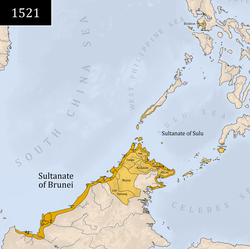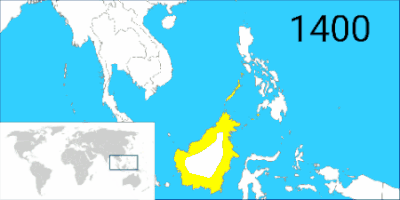1368–1888 Bruneian Sultanate
The Sultanate of Brunei (Jawi: كسلطانن بروني) or simply Brunei (/bruːˈnaɪ/ broo-NY), also known as the Brunei Empire, was a Malay sultanate, centered in Brunei on the northern coast of Borneo Island in Southeast Asia.
Brunei became a sovereign state around the 15th century, when it substantially expanded after the fall of Malacca to the Portuguese, extending throughout coastal areas of Borneo and the Philippines, before it declined in the 17th and 18th centuries. The first ruler or sultan of Brunei was a Muslim. It became a British protectorate in the 19th century.
Sultanate of Brunei | |||||||||||||||||||||||||
|---|---|---|---|---|---|---|---|---|---|---|---|---|---|---|---|---|---|---|---|---|---|---|---|---|---|
| 1363/68–1888 or 1906 | |||||||||||||||||||||||||
 The maximum territorial extent of the Bruneian Empire (yellow) with its vassals (light yellow) in 1521. | |||||||||||||||||||||||||
| Status |
| ||||||||||||||||||||||||
| Capital |
| ||||||||||||||||||||||||
| Common languages | Brunei Malay, Old Malay, Old Tagalog, Kapampangan, Arabic and Bornean languages | ||||||||||||||||||||||||
| Religion | Sunni Islam | ||||||||||||||||||||||||
| Demonym(s) | Bruneian | ||||||||||||||||||||||||
| Government | Monarchy | ||||||||||||||||||||||||
| Sultans | |||||||||||||||||||||||||
• 1363/68–1402 | Sultan Muhammad Shah | ||||||||||||||||||||||||
• 1425–1432 | Sharif Ali | ||||||||||||||||||||||||
• 1485–1524 | Bolkiah | ||||||||||||||||||||||||
• 1582–1598 | Muhammad Hassan | ||||||||||||||||||||||||
• 1828–1852 | Omar Ali Saifuddin II | ||||||||||||||||||||||||
• 1885–1888 | Hashim Jalilul Alam Aqamaddin | ||||||||||||||||||||||||
| History | |||||||||||||||||||||||||
• Establishment of the Sultanate | 1363/68 | ||||||||||||||||||||||||
• Became a British protectorate | 1888 or 1906 | ||||||||||||||||||||||||
| Currency | Barter, Cowrie, Piloncitos, and later Brunei pitis | ||||||||||||||||||||||||
| |||||||||||||||||||||||||
| Today part of | |||||||||||||||||||||||||
Historiography
The limited evidence of contemporary sources poses a challenge in understanding the history of the early Bruneian Sultanate. No local or indigenous sources exist to provide evidence for any of this. As a result, Chinese texts have been relied on to construct the history of early Brunei. Boni in Chinese sources most likely refers to Western Borneo, while Poli (婆利), probably located in Sumatra, is claimed by local authorities to refer to Brunei as well.
History
Pre-sultanate history
In the 1300s the Chinese annals, Nanhai zhi, reported that Brunei invaded or administered Sarawak and Sabah as well as the Philippine kingdoms of: Butuan, Sulu, Ma-i (Mindoro), Malilu (present-day Manila), Shahuchong (present-day Siocon or Zamboanga), Yachen (Oton, once part of the Madja-as Kedatuan), and Wenduling (present-day Mindanao), which would regain their independence at a later date. It eventually evolved to be called Pon-i and it was a vassal-state to the Javanese-centered Majapahit Empire.
In the 14th century, Brunei seems to be subjected to Java. The Javanese manuscript Nagarakretagama, written by Prapanca in 1365, mentioned Barune as the vassal state of Majapahit, which had to make an annual tribute of 40 katis of camphor.
After Majapahit invaded Brunei, its subject kingdoms in the Philippines which was formally under its empire, rebelled against Brunei, chief of which was the former kingdom of Sulu which besieged and pillaged it.
Its (Brunei's) own empire gone, it would appear to have shrunk to its heartland by Brunei bay. It now paid an annual tribute of 40 kati of camphor to the Majapahit Emperor. But worse was to follow. 1369 marks the absolute nadir of Brunei's fortunes, for in that year its former subjects the Suluks put it to sack. So utterly helpless were the Bruneis, that they had to be rescued by the Majapahit fleet, which drove out the intruders, who departed laden with enormous booty and taking the two precious pearls.
— Robert Nicholl, "Brunei Rediscovered: A Survey of Early Times"
Expansion
Following the presence of Portuguese after the fall of Malacca, Portuguese merchants traded regularly with Brunei from 1530 and described the capital of Brunei as surrounded by a stone wall. During the rule of Bolkiah, the fifth sultan, the empire held control over coastal areas of northwest Borneo (present-day Brunei, Sarawak and Sabah) and reached Seludong (present-day Manila) and the Sulu Archipelago, including parts of the island of Mindanao.
In the 16th century, the Brunei empire's influence extended as far as Kapuas River delta in West Kalimantan. The Malay Sultanate of Sambas in West Kalimantan and the Sultanate of Sulu in southern Philippines in particular developed dynastic relations with the royal house of Brunei. Even the Muslim Rajahs of Manila, Rajah Matanda, for example had family-links with the Brunei Sultanate. Other Malay sultans of Pontianak, Samarinda as far as Banjarmasin, treated the sultan of Brunei as their leader. The true nature of Brunei's relationship with other Malay sultanates of coastal Borneo and the Sulu archipelago is still a subject of study, as to whether it was a vassal state, an alliance, or just a ceremonial relationship. Other regional polities also exercised their influence upon these sultanates. The Sultanate of Banjar (present-day Banjarmasin), for example, was also under the influence of Demak in Java. The growth of the Malacca as the largest Southeast Asian entrepôt in the Maritime Silk Road led to a gradual spread of its cultural influence eastward throughout insular Southeast Asia. Malay became the regional lingua franca of trade and many polities enculturated Islamic Malay customs and governance to varying degrees, including Kapampangans, Tagalogs and other coastal Philippine peoples. According to Bruneian folklore, at around 1500 Sultan Bolkiah launched a successful northward expedition to break Tondo’s monopoly as a regional entrepot of the Chinese trade and established Maynila (Selurong) across the Pasig delta, ruled by his heirs as a satellite.
Bruneian influence spread elsewhere around Manila Bay, present-day Batangas, and coastal Mindoro through closer trade and political relations, with a growing overseas Kapampangan-Tagalog population based in Brunei and beyond in Malacca in various professions as traders, sailors, shipbuilders, mercenaries, governors, and slaves.
Decline

The rising power of the nearby Sultanate of Sulu occurred due to infighting between Bruneian nobles and the king. Brunei eventually lost its authority over the Bajaus and lapsed into a collection of riverine territories ruled by semi-autonomous chiefs.
By the end of 17th century, Brunei entered a period of decline brought on by internal strife over royal succession, colonial expansion of the European powers, and piracy. The empire lost much of its territory due to the arrival of the western powers such as the Spanish in the Philippines, the Dutch in southern Borneo and the British in Labuan, Sarawak and North Borneo. By 1725, Brunei had many of its supply routes had been taken over by the Sulu sultanate.
In 1888, Sultan Hashim Jalilul Alam Aqamaddin later appealed to the British to stop further encroachment. In the same year, the British signed a "Treaty of Protection" and made Brunei a British protectorate, which lasted until 1984, when Brunei gained independence.
Government
The sultanate was divided into three traditional land systems known as kerajaan (crown property), kuripan (official property) and tulin (hereditary private property).
References
Further reading
This article uses material from the Wikipedia English article Bruneian Sultanate (1368–1888), which is released under the Creative Commons Attribution-ShareAlike 3.0 license ("CC BY-SA 3.0"); additional terms may apply (view authors). Content is available under CC BY-SA 4.0 unless otherwise noted. Images, videos and audio are available under their respective licenses.
®Wikipedia is a registered trademark of the Wiki Foundation, Inc. Wiki English (DUHOCTRUNGQUOC.VN) is an independent company and has no affiliation with Wiki Foundation.


